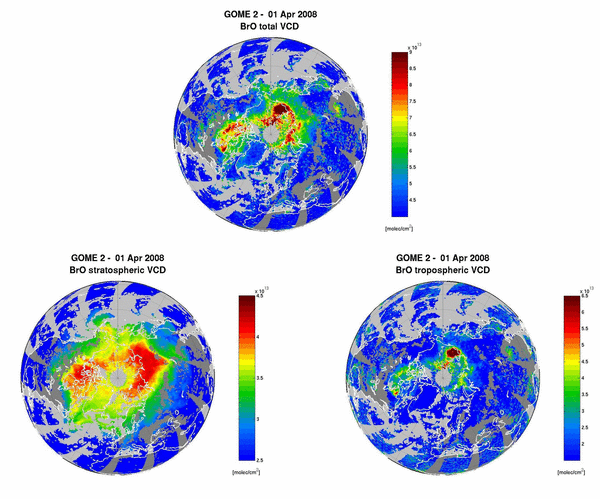|
~
|
GOME-2 BrO results
Launched in October 2006, the GOME-2 instrument is a nadir looking UV-visible spectrometer that flies aboard the MetOp-A satellite (Munro et al., 2006).
Compared to its predecessors GOME and SCIAMACHY, GOME-2 combines the advantages of a performant spectroscopic design and both good spatial resolution and coverage.
Using an advanced retrieval technique further described below, we separate the stratospheric and tropospheric contributions from the total BrO seen by the satellite.
These results demonstrate the potential of GOME-2 to quantify and follow the transport of BrO plumes formed in the Arctic boundary layer.
The BrO columns are derived in three steps:
Satellite total BrO column hotspots seen by GOME-2 exhibit spatial patterns similar to model estimates of stratospheric BrO column. A closer look to the BrO columns results shows also that several BrO hotspots are observed in both stratospheric columns and tropospheric residual columns. This can not be explained by a mismatch in the stratospheric BrO correction. This interesting feature emphasizes the need, for a proper quantitative interpretation of the results, to separate the BrO total columns into their stratospheric and tropospheric contributions. These results can be used to better understand the mechanisms for BrO generation in the arctic troposphere (leading e.g. to ozone and mercury depletion episodes in the boundary layer). In the future, we intend to apply the same algorithm to measurements from other sensors with the aim to create a long-term consistent database of tropospheric measurement from space. * The stratospheric BrO correction is based on a dynamical climatology generated from the BASCOE 3D chemical transport model. This climatology explicitly accounts for the impact of atmospheric dynamics and photochemistry on the stratospheric BrO distribution based on a parameterization using O3 and NO2 columns measured as an input (Theys et al., 2009).
References: |




